| Listing 1 - 10 of 214 | << page >> |
Sort by
|
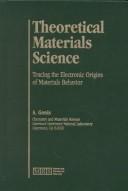
ISBN: 1558995404 9781558995406 Year: 2000 Publisher: Warrendale (Pa.): Materials research society,
Abstract | Keywords | Export | Availability | Bookmark
 Loading...
Loading...Choose an application
- Reference Manager
- EndNote
- RefWorks (Direct export to RefWorks)
Solid state electronics. --- Materials science --- Solid state electronics --- Material science --- Monograph --- Electronics --- Semiconductors --- Solid state physics --- Physical sciences
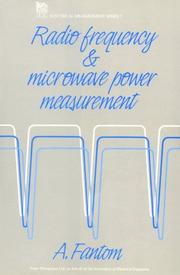
ISBN: 0863411207 Year: 1990 Publisher: London Peregrinus
Abstract | Keywords | Export | Availability | Bookmark
 Loading...
Loading...Choose an application
- Reference Manager
- EndNote
- RefWorks (Direct export to RefWorks)
Electric measurements --- Electric meters --- Radio frequency --- Microwaves --- Hertzian waves --- Electric waves --- Electromagnetic waves --- Geomagnetic micropulsations --- Radio waves --- Shortwave radio --- Radiofrequency --- Frequencies of oscillating systems --- Radio measurements --- Meters, Electric --- Electric apparatus and appliances --- Utility meters --- Measurements, Electric --- Electromagnetic measurements --- Physical measurements --- Weights and measures --- Electronic measurements --- Measurement --- Electric measurements. --- Electric meters. --- Microwaves. --- Radio frequency.
Book
ISBN: 0946655669 Year: 1992 Publisher: Letchworth Technical communications
Abstract | Keywords | Export | Availability | Bookmark
 Loading...
Loading...Choose an application
- Reference Manager
- EndNote
- RefWorks (Direct export to RefWorks)
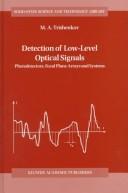
ISBN: 0792346912 9048148928 9401512906 Year: 1997 Publisher: Dordrecht Kluwer
Abstract | Keywords | Export | Availability | Bookmark
 Loading...
Loading...Choose an application
- Reference Manager
- EndNote
- RefWorks (Direct export to RefWorks)
This book is addressed to designers of photodetectors and photodetecting systems, designers of focal plane arrays, charge-coupled devices, specialists in IR technologies, designers of optoelectronic detecting, guiding and tracking systems, systems for IR direction finders, lidars, lightwave communication systems, IR imagers. All these specialists are united by one common purpose: they are all striving to catch the weakest possible optical signal. The most important characteristic of photosensitive devices is their detectivity, which determines the lowest level of optical signal they are able to detect above the noise level. These threshold characteristics define the most important tactical and technical parameters of the entire optoelectronic system, such as its range, resolution, precision. The threshold characteristics of optoelectronic system depend on many of its components; all designers agree, however, that the critically responsible part of the system is the photodetector [1]. By the end of the 1960s the physicists and the engineers were able to overcome many obstacles and to create photodetectors (at least single-element or few-element ones) which covered all the main optical bands (0. 4 . . . 2,2 . . . 3, 3 . . . 5,8 . . . 14 J. . Lm), carried out the detection almost without any loss (the quantum yield being as high as 0. 7 . . . 0. 9), and reduced the noise level to the lowest possible limit.
Charge coupled devices. --- Focal planes. --- Optical detectors. --- Optoelectronic devices. --- Signal processing. --- Charge coupled devices --- Focal planes --- Optical detectors --- Optoelectronic devices --- Signal processing --- Photo electric devices --- Photo electronic devices --- Photoelectronic devices --- Electronic apparatus and appliances --- Optical instruments --- Electrooptical devices --- Integrated optics --- Light-sensitive cells --- Light-sensitive detectors --- Light sensor photodevices --- Photodetectors --- Photodevices, Light sensor --- Photoelectric detectors --- Photosensors --- Detectors --- Optical transducers --- Processing, Signal --- Information measurement --- Signal theory (Telecommunication) --- Planes, Focal --- Optics --- CCD (Electronics) --- Image converters --- Integrated circuits --- Charge transfer devices (Electronics) --- Metal oxide semiconductors --- Equipment and supplies --- Lasers. --- Photonics. --- Electrical engineering. --- Optical data processing. --- Optical materials. --- Electronic materials. --- Automotive engineering. --- Optics, Lasers, Photonics, Optical Devices. --- Electrical Engineering. --- Image Processing and Computer Vision. --- Optical and Electronic Materials. --- Automotive Engineering. --- Electronic materials --- Materials --- Optical computing --- Visual data processing --- Bionics --- Electronic data processing --- Photonics --- Computers --- Electric engineering --- Engineering --- New optics --- Light amplification by stimulated emission of radiation --- Masers, Optical --- Optical masers --- Light amplifiers --- Light sources --- Nonlinear optics --- Optical parametric oscillators --- Optical equipment --- Photonic devices --- Photonic instruments
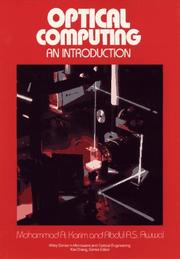
ISBN: 0471528862 Year: 1992 Volume: vol *3 Publisher: New York Wiley
Abstract | Keywords | Export | Availability | Bookmark
 Loading...
Loading...Choose an application
- Reference Manager
- EndNote
- RefWorks (Direct export to RefWorks)
Information [Traitement optique de l' ] --- Optical computing --- Optical data processing --- Optische gegevensverwerking --- Visual data processing --- 519.67 --- Bionics --- Electronic data processing --- Integrated optics --- Photonics --- Computers --- Machine, graphical and other methods of computational mathematics --- Optical equipment --- 519.67 Machine, graphical and other methods of computational mathematics --- Optical data processing. --- Optoelectronics --- Traitement optique de l'information --- Optoélectronique --- Traitement optique de l'information. --- Optoélectronique.
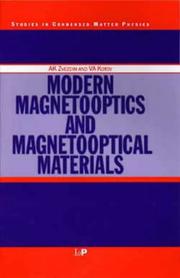
ISBN: 075030362X Year: 1997 Publisher: Bristol Institute of physics
Abstract | Keywords | Export | Availability | Bookmark
 Loading...
Loading...Choose an application
- Reference Manager
- EndNote
- RefWorks (Direct export to RefWorks)
Magnetooptical devices --- -Magnetooptics --- Magneto-optical effects --- Magneto-optics --- Magnetooptical effects --- Optical phenomena, Influence of magnetism on --- Optics --- Magneto-optical devices --- Magnetic devices --- Materials --- Magnetooptics. --- Materials. --- Magnetooptics --- MAGNETOOPTICAL DEVICES --- MAGNETOOPTICS --- MATERIALS
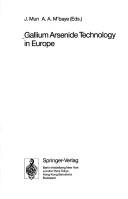
Abstract | Keywords | Export | Availability | Bookmark
 Loading...
Loading...Choose an application
- Reference Manager
- EndNote
- RefWorks (Direct export to RefWorks)
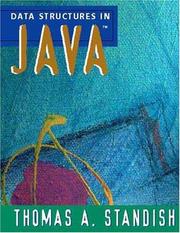
ISBN: 020130564X Year: 1998 Publisher: Reading Addison-Wesley
Abstract | Keywords | Export | Availability | Bookmark
 Loading...
Loading...Choose an application
- Reference Manager
- EndNote
- RefWorks (Direct export to RefWorks)
Programming --- Java (informatica) --- object oriented --- 681.3*D3 --- 681.3*D32 --- datastructuur --- java --- Programming languages --- language classifications: applicative languages; data-flow languages; design languages; extensible languages; macro and assembly languages; nonprocedural languages; specialized application and very high-level languages (Programminglanguages) --- Data structures (Computer science) --- Java (Computer program language) --- Java (programmeertaal) --- Data structures (Computer science). --- Java (Computer program language). --- Java (programmeertaal). --- 681.3*D32 language classifications: applicative languages; data-flow languages; design languages; extensible languages; macro and assembly languages; nonprocedural languages; specialized application and very high-level languages (Programminglanguages) --- 681.3*D3 Programming languages --- Object-oriented programming languages --- JavaSpaces technology --- Information structures (Computer science) --- Structures, Data (Computer science) --- Structures, Information (Computer science) --- Electronic data processing --- File organization (Computer science) --- Abstract data types (Computer science)

ISBN: 9781584886877 1584886870 Year: 2007 Publisher: Boca Raton Chapman & Hall/CRC
Abstract | Keywords | Export | Availability | Bookmark
 Loading...
Loading...Choose an application
- Reference Manager
- EndNote
- RefWorks (Direct export to RefWorks)
Electrical engineering --- Organic chemistry --- Nanostructured materials. --- Nanotechnology. --- Microelectromechanical systems. --- Self-assembly (Chemistry) --- Nanomatériaux --- Nanotechnologie --- Micromachines --- Autoassemblage --- 658.515 --- Assembly work. Assembling --- 658.515 Assembly work. Assembling --- Nanomatériaux --- Microelectromechanical systems --- Nanostructured materials --- Nanotechnology --- Self-organizing systems --- Molecular technology --- Nanoscale technology --- High technology --- Nanomaterials --- Nanometer materials --- Nanophase materials --- Nanostructure controlled materials --- Nanostructure materials --- Ultra-fine microstructure materials --- Microstructure --- MEMS (Microelectromechanical systems) --- Micro-electro-mechanical systems --- Micro-machinery --- Microelectromechanical devices --- Micromachinery --- Micromechanical devices --- Micromechanical systems --- Electromechanical devices --- Microtechnology --- Mechatronics --- Materials sciences
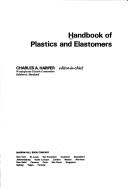
ISBN: 0070266816 9780070266810 Year: 1975 Publisher: New York: McGraw-Hill,
Abstract | Keywords | Export | Availability | Bookmark
 Loading...
Loading...Choose an application
- Reference Manager
- EndNote
- RefWorks (Direct export to RefWorks)
elastomer --- mechanische technologie --- Industrial chemistry --- kunststoffen --- 62-039.5 --- Elastomers --- -Plastics --- -Plastic materials --- Plastic products --- Polymers --- Synthetic products --- Condensation products (Chemistry) --- Plasticity --- Elastomeric materials --- Reinforced elastomers --- Plastics --- Rubber --- Polymer matrix composites --- Handbooks, manuals, etc --- -Polymer matrix composites --- 62-039.5 Polymer matrix composites --- -62-039.5 Polymer matrix composites --- Plastic materials --- Handbooks, manuals, etc. --- Plastics - Handbooks, manuals, etc. --- Elastomers - Handbooks, manuals, etc.
| Listing 1 - 10 of 214 | << page >> |
Sort by
|

 Search
Search Feedback
Feedback About UniCat
About UniCat  Help
Help News
News